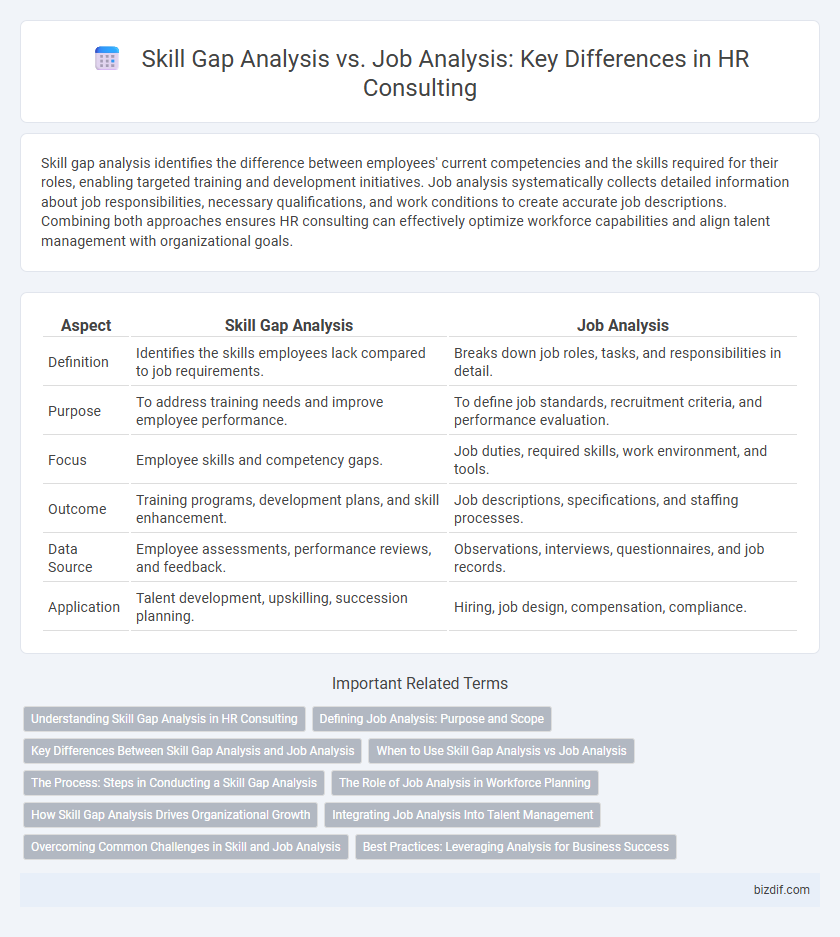Skill gap analysis identifies the difference between employees' current competencies and the skills required for their roles, enabling targeted training and development initiatives. Job analysis systematically collects detailed information about job responsibilities, necessary qualifications, and work conditions to create accurate job descriptions. Combining both approaches ensures HR consulting can effectively optimize workforce capabilities and align talent management with organizational goals.
Table of Comparison
| Aspect | Skill Gap Analysis | Job Analysis |
|---|---|---|
| Definition | Identifies the skills employees lack compared to job requirements. | Breaks down job roles, tasks, and responsibilities in detail. |
| Purpose | To address training needs and improve employee performance. | To define job standards, recruitment criteria, and performance evaluation. |
| Focus | Employee skills and competency gaps. | Job duties, required skills, work environment, and tools. |
| Outcome | Training programs, development plans, and skill enhancement. | Job descriptions, specifications, and staffing processes. |
| Data Source | Employee assessments, performance reviews, and feedback. | Observations, interviews, questionnaires, and job records. |
| Application | Talent development, upskilling, succession planning. | Hiring, job design, compensation, compliance. |
Understanding Skill Gap Analysis in HR Consulting
Skill gap analysis in HR consulting identifies the difference between employees' current abilities and the skills required for optimal job performance, enabling targeted training and development. This method contrasts with job analysis, which systematically outlines job duties, responsibilities, and necessary qualifications without assessing existing employee competencies. By focusing on skill gap analysis, HR consultants can create strategic workforce plans that enhance productivity and address specific talent deficiencies within organizations.
Defining Job Analysis: Purpose and Scope
Job analysis systematically identifies the tasks, responsibilities, and skills required for a specific role, providing a foundation for recruitment, training, and performance management. Its primary purpose is to define the job's scope and essential competencies to ensure alignment with organizational goals. Skill gap analysis, by contrast, evaluates current employee capabilities against these job requirements to pinpoint areas for development and upskilling.
Key Differences Between Skill Gap Analysis and Job Analysis
Skill gap analysis identifies discrepancies between employees' current skills and the skills required for effective job performance, emphasizing workforce development and training needs, while job analysis systematically examines job duties, responsibilities, and required qualifications to create accurate job descriptions and specifications. Skill gap analysis is forward-looking and adaptive, focusing on future skill requirements to support organizational growth, whereas job analysis provides a static snapshot of job roles to ensure HR processes like recruitment and performance evaluation are aligned with job expectations. Both analyses are foundational in HR consulting but serve different strategic purposes: skill gap analysis drives learning and development initiatives, and job analysis underpins talent acquisition and compensation structures.
When to Use Skill Gap Analysis vs Job Analysis
Skill gap analysis is essential when organizations aim to identify current employee competencies versus required skills for future roles, enabling targeted training and development programs. Job analysis is most effective for defining job roles, responsibilities, and qualifications during recruitment, job design, and performance management. Use skill gap analysis during talent development and succession planning, while job analysis should be prioritized in hiring processes and organizational restructuring.
The Process: Steps in Conducting a Skill Gap Analysis
Conducting a skill gap analysis begins with identifying the required competencies and skills for specific job roles through a comprehensive job analysis. The next step involves assessing current employee capabilities using performance evaluations, surveys, and interviews to gather relevant data. Finally, comparing required skills with existing employee skills helps prioritize training needs and develop targeted development plans for organizational growth.
The Role of Job Analysis in Workforce Planning
Job analysis plays a critical role in workforce planning by identifying the specific duties, responsibilities, and qualifications required for each position, enabling precise skill gap analysis. Accurate job analysis data allows HR consultants to align recruitment, training, and development strategies with organizational goals. This ensures optimal talent allocation and addresses workforce deficiencies effectively.
How Skill Gap Analysis Drives Organizational Growth
Skill gap analysis identifies the specific competencies employees lack, allowing organizations to tailor training programs that enhance workforce capabilities and productivity. Unlike job analysis, which outlines job responsibilities and requirements, skill gap analysis directly targets developmental needs, accelerating talent development and innovation. By aligning skills with strategic goals, companies foster agility and sustain competitive advantage in dynamic markets.
Integrating Job Analysis Into Talent Management
Skill gap analysis identifies discrepancies between current employee abilities and job requirements, while job analysis systematically examines job roles to define essential skills and responsibilities. Integrating job analysis into talent management enhances recruitment, training, and performance evaluation by providing precise role definitions that align with organizational goals. This integration ensures targeted development plans and strategic workforce planning to optimize productivity and close skill gaps effectively.
Overcoming Common Challenges in Skill and Job Analysis
Skill gap analysis identifies specific competencies employees lack to meet job requirements, while job analysis defines the duties, responsibilities, and necessary qualifications for a position. Overcoming challenges in both processes involves leveraging data-driven assessments and employee feedback to ensure accurate identification of skill deficiencies and role expectations. Integrating advanced HR technologies enhances accuracy, reduces bias, and supports continuous alignment of workforce capabilities with organizational goals.
Best Practices: Leveraging Analysis for Business Success
Skill gap analysis identifies the discrepancies between current employee competencies and those required for optimal job performance, enabling targeted training and development programs. Job analysis systematically defines the responsibilities, skills, and qualifications essential for each position, ensuring accurate job descriptions and effective recruitment strategies. Leveraging both analyses together supports strategic workforce planning, enhances employee performance, and drives business success by aligning talent capabilities with organizational goals.
Skill gap analysis vs job analysis Infographic

 bizdif.com
bizdif.com